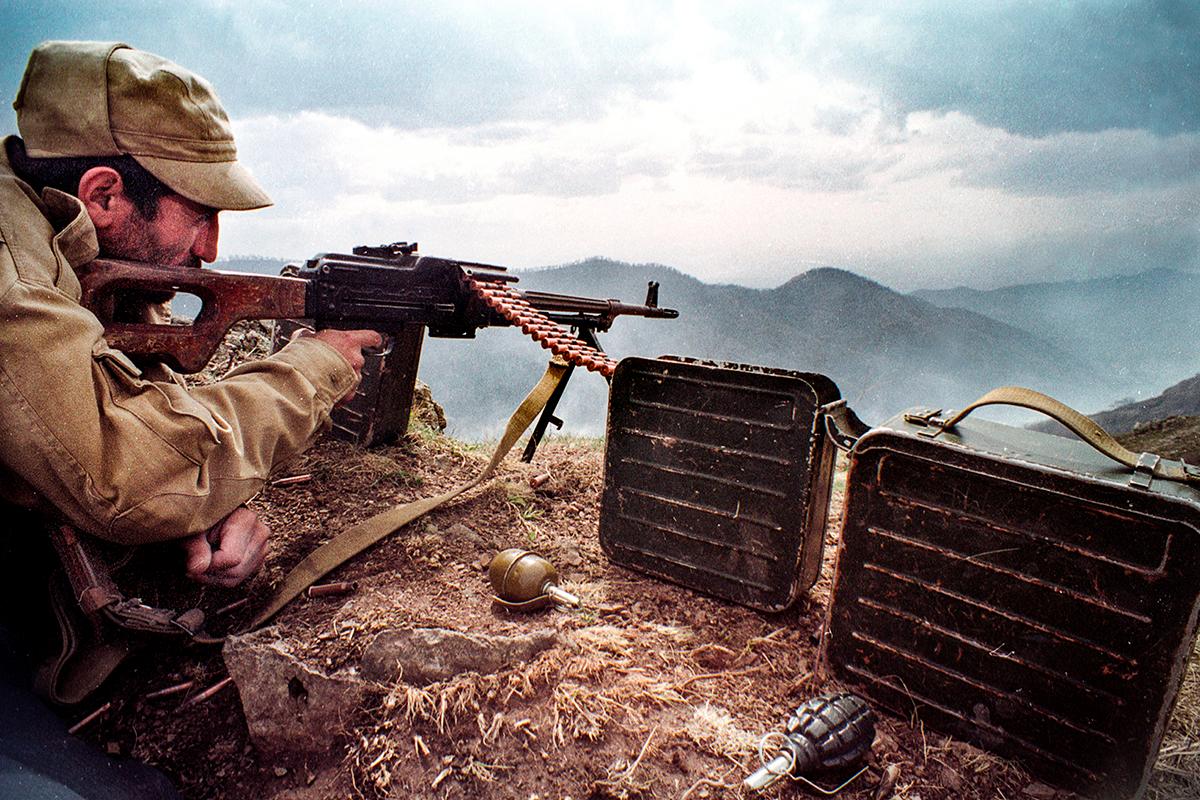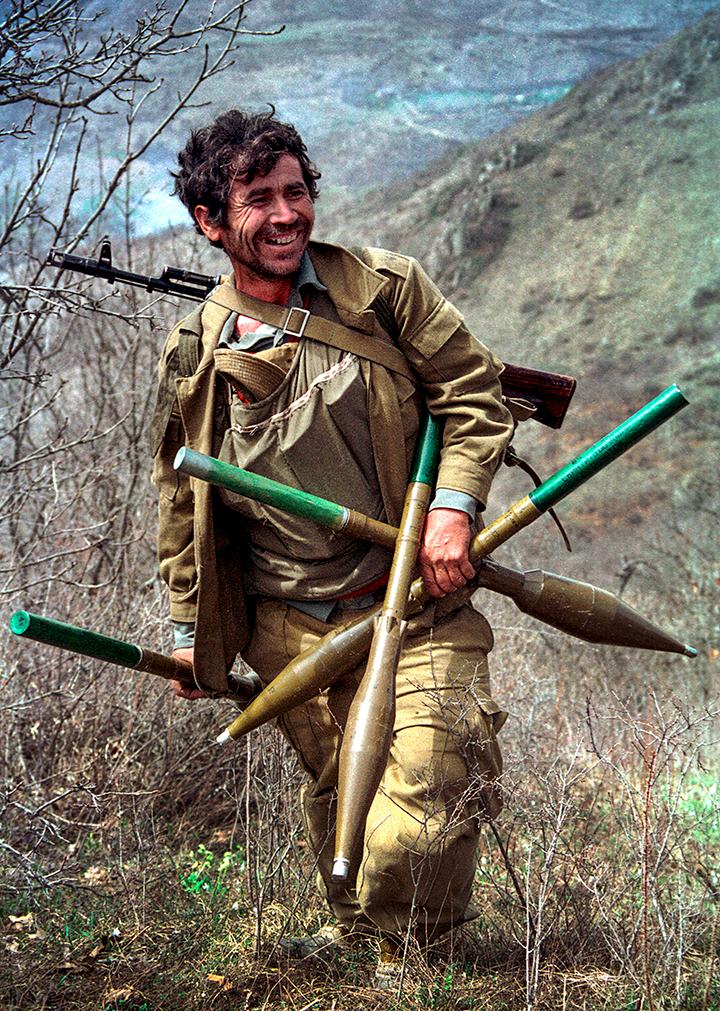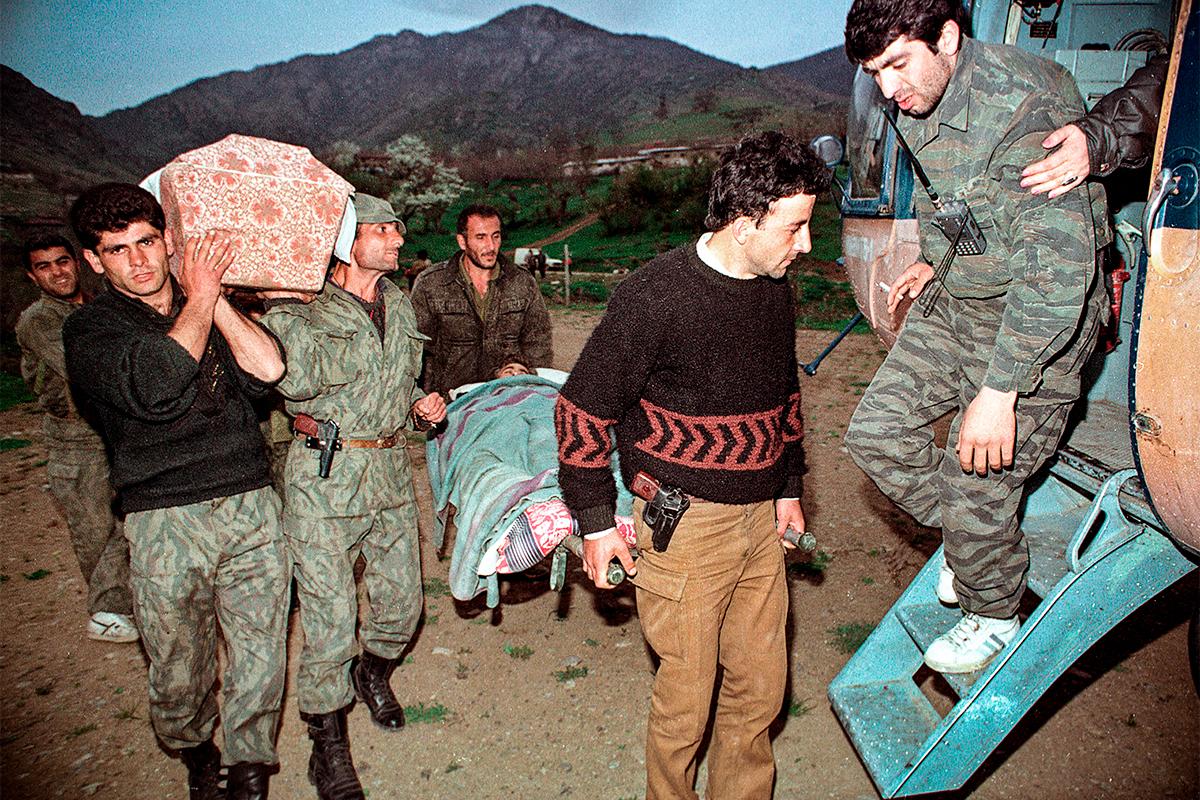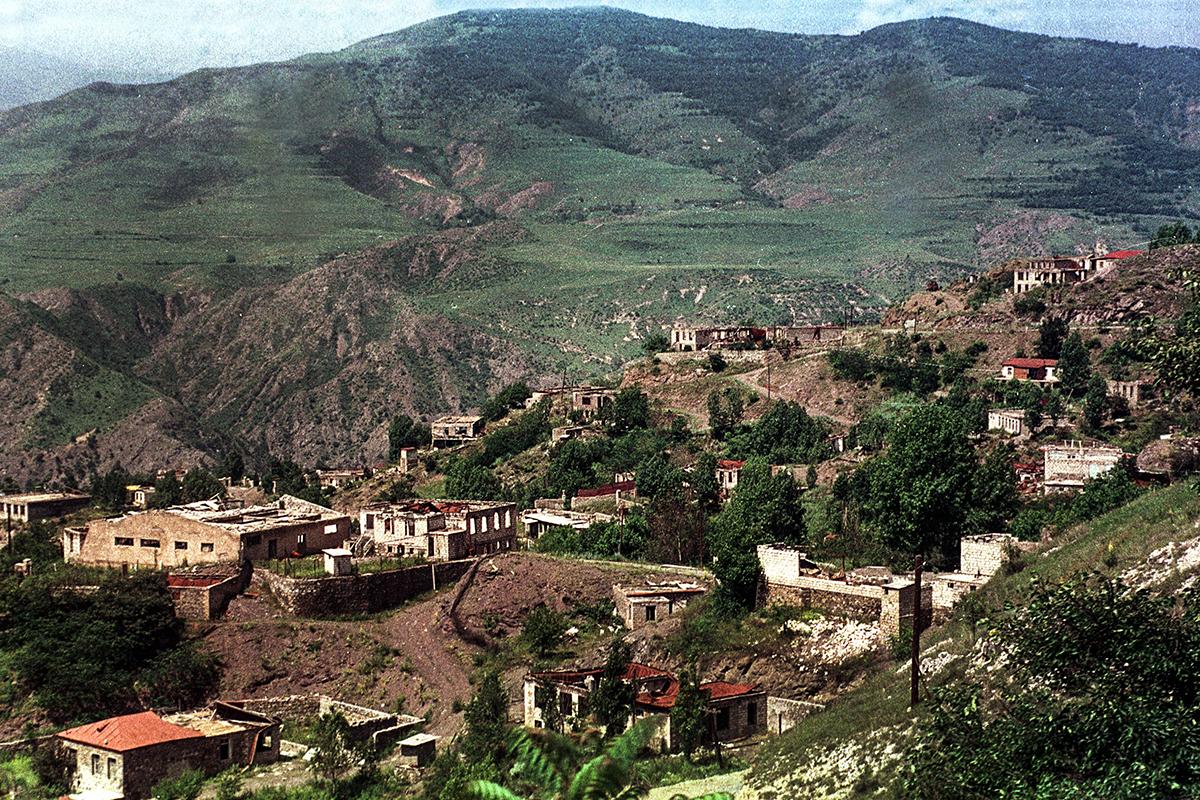Battle for Karabakh: 30th anniversary of longest-running war in former USSR
KARABAKH 12 August 2022 - 18:23
Exactly 30 years ago in August 1992, deputies of the Supreme Council of the unrecognized Nagorno Karabakh Republic (NKR) imposed martial law on the region and announced a general mobilization. The conflict between Armenia and Azerbaijan escalated to a new level: with the collapse of the USSR, the allied authorities no longer controlled the warring parties, which were able to use the weapons left by the Soviet army. The first Karabakh war, which lasted until May 1994, claimed the lives of more than 30,000 people and made more than a million people refugees. This conflict became a defining factor in post-Soviet history and an integral part of the modern identity of Azerbaijanis and Armenians.
Lenta.Ru presented the history of the first bloody war in Nagorno-Karabakh in the photographs of Alexander Nemenov.
Harbinger of the storm

Armenian soldier in the village of Hin Tagher (Azerbaijani name: Kohne Taghlar)
The modern history of the conflict starts with Gorbachev's perestroika in the 1980s and the rise of national movements on the territory of the Soviet Union. As part of the Azerbaijani SSR, Nagorno-Karabakh had the status of an autonomous region but was predominantly populated by Armenians.
Back in the late 1980s, Armenians asked the Soviet leadership to transfer them under the jurisdiction of the Armenian SSR. The movement for the unification of Karabakh with Armenia caused a surge of emotions in the Azerbaijani SSR. The clashes between the representatives of the communities soon resulted in the exodus of the Azerbaijani population from the Armenian SSR and Nagorno-Karabakh and pogroms in Azerbaijani cities, including Baku. The Soviet leadership tried to solve the issue by force, but this only led to the growing popularity of national identity ideas in both republics.
In December 1991, a referendum was held in Nagorno-Karabakh, where the majority voted for independence from the Azerbaijani SSR, followed by an armed conflict.
Disintegration processes

Azerbaijani soldiers firing a machine gun on the front line near the town of Aghdam, May 1992
In 1991, with the beginning of the collapse of the Soviet Union, the struggle for Nagorno-Karabakh entered a new phase. First, the Republic of Azerbaijan proclaimed its independence on August 30, 1991, and then on September 2, the unrecognized Nagorno-Karabakh Republic proclaimed its independence. Baku did not recognize Stepanakert's decision. As for Yerevan, the declaration of independence was adopted on August 23, 1990, and on September 23, 1991, the results of the referendum on withdrawal from the Soviet Union were officially announced there.
The Kremlin still tried to take control of the situation in Nagorno-Karabakh, and for a while, it succeeded: the Soviet Army and the militia of the Azerbaijani SSR conducted joint operations against the Armenian detachments. But by the end of 1991, the USSR had collapsed, and the Soviet army simply disappeared. On December 27, the Internal Troops of the Russian Interior Ministry completely left the region, and the situation in the region became uncontrollable.
The trial of strength

Armenian soldier aims at the Azerbaijani soldiers at the positions near the village of Khtsaberd (Azerbaijani name: Chaylakkala), April 1993
By the beginning of the war, the Azerbaijani armed forces significantly outnumbered the Armenian and Karabakh units, both in terms of numbers and technical equipment. At the same time, Ukrainian nationalists, Afghan mujahideen, and fighters from the Muslim republics of the former Soviet Union and the Middle East fought against Armenians on the Azerbaijani side. Among the latter were the well-known Chechen terrorists Salman Raduyev and Shamil Basayev, the Arab mercenary and field commander Khattab.
Numerous volunteers from the international Armenian diaspora have sided with Armenia. Some of them came from the Middle East. In addition, the Nagorno-Karabakh forces were supported by representatives of other unrecognized republics - Abkhazia, Transnistria, and South Ossetia.
A tough nut to crack

Armenian soldier near the village of Khtsaberd (Azerbaijani name: Chaylakkala) in Hadrut region of Nagorno-Karabakh, April 1993
The capture of Shusha by Armenian troops was the turning point of the 1992-1994 war. Built around a fortress erected on a two-three square kilometer plateau, it became an impregnable regional outpost. Its possession was largely decisive in determining the outcome of the ensuing confrontation.
The battles for the city ended on May 9, 1992. It took the Armenian military around 24 hours to assault the city; many people who later enjoyed prominent political careers, in particular, Robert Kocharyan, the future president of NKR and later of Armenia, and Samvel Babayan, the future NKR Defence Minister, took part in the assault.
The Azerbaijani soldiers abandoned their armored vehicles and missile launchers in the city, where they lost 150-200 people. The Armenian side lost about fifty people.
Losses of the parties
Despite Baku's numerical and technical superiority, the military luck in the Karabakh conflict turned out to be on the side of Yerevan and Stepanakert. No one has reliably confirmed the general data on losses, but according to the most realistic estimates, they amounted to 7-8 thousand killed on the Armenian side and 15-18 thousand on the Azerbaijani side.
During the armed conflict, Armenia acknowledged the loss of 52 T-72 tanks, 54 infantry fighting vehicles, 40 armored personnel carriers, 6 guns, and mortars. Azerbaijan, according to unofficial data, lost 186 tanks (T-72 and T-55), 111 infantry fighting vehicles, 8 armored personnel carriers, 7 self-propelled artillery units, 47 guns, and mortars, at least 7 helicopters, and about 11 aircraft.
Humanitarian disaster

Azerbaijani refugees from Karabakh receive free bread in Imishli, 250 km away from Baku, February 1994
The war in Nagorno-Karabakh took a heavy toll on civilians. As a result of operations from the Azerbaijani and Armenian sides, hundreds of thousands of people from Karabakh villages were forced to leave their homes. Losses of the Armenian civil population as a result of shootings and bombardments in Nagorno-Karabakh amounted to more than a thousand people. There is no information about the killed Azerbaijanis. Refugees and displaced persons from both sides were more than a million people.
In the dark sky

Armenian soldiers load bodies of killed and wounded soldiers on board a helicopter near the village of Hin Tagher (Azerbaijani name: Kohne Taghlar), Hadrut region, April 1993
Non-combatant aircraft also often became victims of shells. Thus, on 20 November 1991, even before the full-scale hostilities started, near the village of Qarakend in Nagorno-Karabakh, the Armenian military shot down a Mi-8 helicopter of USSR Interior Ministry troops, carrying high-ranking officials of the Azerbaijan SSR and observers from the RSFSR and Kazakh SSR.
On 28 January 1992, the Armenian military shot down an Azerbaijani civilian Mi-8 helicopter flying to Shusha. Several dozens of victims died in the crash. On 3 March of the same year, a Russian Mi-26 military transport helicopter carrying almost 50 women and children to Yerevan was shot down near the village of Gulistan. As a result, 16 people were killed.
Fragile peace

View of the burned-out city of Lachin, June 1994
As a result of the war, Nagorno-Karabakh gained de facto independence from Azerbaijan. In addition, Armenian units formed a security belt around Nagorno-Karabakh, adding fully or partially seven neighboring districts of the former Azerbaijani SSR: Kalbajar, Lachin, Gubadli, Jabrayil, Zangilan, Aghdam, Fuzuli. Together with the territory of Nagorno Karabakh itself, it is about 19 thousand square kilometers.
In May 1994, the trilateral ceasefire protocol was signed in Bishkek, inked by the Minister of Defence of Azerbaijan Mammadrafi Mammadov, the Minister of Defence of Armenia Serzh Sargsyan (the future president), and the Minister of Defence of the unrecognized Nagorno-Karabakh Republic Samvel Babayan.
That was the beginning of the negotiation process, which is still underway today under the auspices of the OSCE Minsk Group with the participation of Russia, France, and the United States.
On the verge

Azerbaijani women at the tomb of soldiers killed in Karabakh. Baku, February 1994
Meetings and negotiations, including those under the auspices of the OSCE Minsk Group, which had been going on ever since had yielded no results. The closest breakthrough came in 2001, when Azerbaijani President Heydar Aliyev and Armenian President Robert Kocharyan met in Key West, USA, to sign a peace agreement. But the signing fell through at the last moment.
Caliber.Az
|
1
|
Iran re-evaluating its ties with Azerbaijan, Armenia Baku - more important, honest partner than Yerevan
25 April 2024 - 12:00
|
|
2
|
"Peoples of South Caucasus should resolve their differences independently" Foreign analysts on Caliber.Az
24 April 2024 - 17:40
|
|
3
|
Mark Rutte seeks Türkiye's backing for new job A new pair of hands
24 April 2024 - 16:55
|
|
4
|
Bilateral relations, regional dynamics, & peacekeepers’ withdrawal Key takeaways from President Aliyev's Moscow visit
24 April 2024 - 14:07
|
|
5
|
Air France plane safely evacuated at Heydar Aliyev Int’l Airport
24 April 2024 - 19:08
|
China passes tariff law as tensions with trading partners simmer
27 April 2024 - 01:03
Azerbaijani, German presidents hold expanded meeting
26 April 2024 - 23:50
Azerbaijani President, German Chancellor hold joint press conference
26 April 2024 - 23:45
Mount Fuji view to be blocked as tourists overcrowd popular photo spot
26 April 2024 - 23:00
Türkiye bases its relations with African countries on win-win principle: Parliament speaker
26 April 2024 - 20:53
ICJ concludes public hearings on 'Azerbaijan v. Armenia' case, proceeds to evidence verification
26 April 2024 - 20:45
Turkic parliament committee chairmen tour Khankendi & Shusha in Azerbaijan
26 April 2024 - 20:39
ByteDance prefers TikTok shutdown in US over sale
26 April 2024 - 20:39
Health Ministry: Over 50 Palestinians killed in Gaza as Israeli onslaught continues
26 April 2024 - 20:26
Azerbaijani president meets German FM in Berlin, discusses COP29 & peace agenda
26 April 2024 - 20:22
Russia, Ukraine hand over bodies of dead soldiers
26 April 2024 - 20:11
Political analyst: Armenian leadership hostile towards Russia
26 April 2024 - 19:56
Israeli civilian fatally injured in anti-tank missile strike near Lebanon border
VIDEO26 April 2024 - 19:41
Turkish court sentences Syrian woman to life in prison for bombing in Istanbul in 2022
26 April 2024 - 19:26
Azerbaijani, Kazakh military specialists convene for bilateral co-op discussions
26 April 2024 - 19:16
Armenia, Italy agree on military-technical cooperation
26 April 2024 - 19:11
Kazakhstan hosting meeting of defence ministers of SCO member states
26 April 2024 - 18:56
Azerbaijan, Armenia install 28 markers as border clarification works reach 35% completion
26 April 2024 - 18:50
UK’s ministry: Russian forces accelerating advance west of Ukraine’s Avdiivka
26 April 2024 - 18:41
Kazakh military delegation explores Azerbaijan's defense capabilities during visit
26 April 2024 - 18:35
France, Germany push on with 2040 joint tank project
26 April 2024 - 18:26
Political analyst: Demarcation of border with Azerbaijan meets Armenia’s vital interests
26 April 2024 - 18:11
Palestinian Resistance factions fighting against Israeli forces across besieged Gaza Strip
26 April 2024 - 17:56
US Central Command conducts humanitarian airdrops into Gaza
26 April 2024 - 17:41
Azerbaijan unveils programme of sixth World Forum on Intercultural Dialogue in Baku
26 April 2024 - 17:26
Azerbaijan's energy offer signals path to normalization with Armenia
Amid geopolitical shifts26 April 2024 - 17:24
Spain to send Patriot missiles to Ukraine
26 April 2024 - 17:11
Russia's oil revenues grow despite Western sanctions
Bill of the war26 April 2024 - 17:05
US, China spar over bilateral, global issues
26 April 2024 - 16:56
Kyrgyzstan's school-building gesture in Karabakh signals deeper ties with Azerbaijan
26 April 2024 - 16:41
Armenian PM vows to tackle existential challenges
We will address this issue26 April 2024 - 16:30
Azerbaijani police find explosive devices, ammunition in Khojavend
PHOTO26 April 2024 - 16:28
IAEA: Situation at Zaporizhzhia Nuclear Power Plant remains unpredictable
26 April 2024 - 16:13
US Mojave proves its unmatched versatility in unprecedented live-fire demo
26 April 2024 - 15:58
From energy cooperation to investment expansion
Baku, Budapest forge stronger business ties26 April 2024 - 15:45
Russian operation to seize Chasiv Yar offers most immediate prospects for significant advances
ISW analysts’ opinion26 April 2024 - 15:43
Turkish president to meet with US counterpart at White House in May
26 April 2024 - 15:28
Sweden to move ahead with sending troops to Latvia as part of NATO forces
26 April 2024 - 15:13
Armenian, Serbian FMs discuss regional issues
26 April 2024 - 14:58
COP29 leadership team, Spanish minister discuss Presidency’s Plan
26 April 2024 - 14:43
